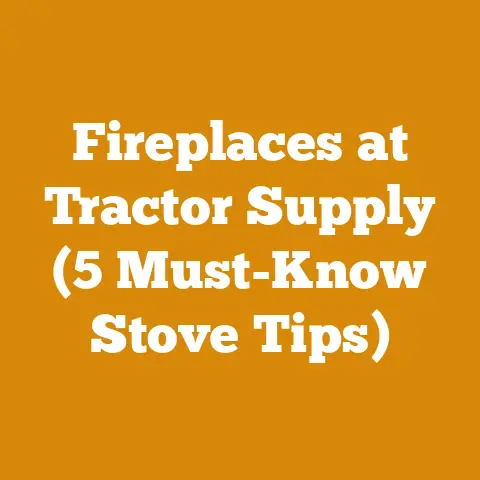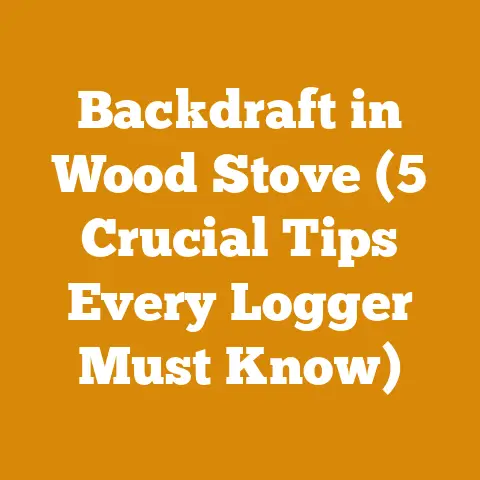Hotblast Wood Furnace Review (Long-Term User Insights & Tips)
The more you burn, the more you save. Or so they say. But what if the “saving” comes at the cost of constant tinkering, sleepless nights, and a chimney that looks like it’s auditioning for a Dickens novel? That’s the paradox I wrestled with when I decided to ditch the oil furnace and embrace the fiery heart of a Hotblast wood furnace.
For years, I’d been watching my heating bills climb higher than a seasoned logger scaling a redwood. The romantic image of a crackling wood fire, warming my home with sustainably harvested timber, beckoned. The Hotblast seemed like the answer – a robust, efficient wood furnace promising to slash those bills and deliver a cozy, wood-fired warmth.
Now, after several seasons of stoking its belly, splitting mountains of wood, and learning the intricate dance of air controls and draft, I’m ready to share my long-term user insights. This isn’t a brochure-perfect review. This is the nitty-gritty, the highs and lows, the lessons learned through sweat, smoke, and the occasional near-disaster. So, grab your gloves, because we’re about to dive deep into the world of the Hotblast wood furnace.
Hotblast Wood Furnace: A Long-Term User’s Perspective
My journey with the Hotblast hasn’t been a straight line. There have been moments of pure wood-burning bliss, where the house was toasty warm, and the woodpile seemed to replenish itself magically. And then there were the moments of frustration, when the fire refused to cooperate, the smoke billowed like a disgruntled dragon, and I questioned my sanity for ever abandoning the predictable hum of the oil burner.
Is the Hotblast Right for You? Assessing Your Needs and Expectations
Before you even think about ordering a Hotblast, it’s crucial to honestly assess your needs and expectations. A wood furnace is a significant investment, both financially and in terms of time and effort. It’s not a “set it and forget it” appliance like a modern gas furnace. It demands attention, physical labor, and a willingness to learn.
Factors to Consider:
- Heating Needs: How large is your home? What’s the climate like in your area? The Hotblast comes in various sizes, so it’s essential to choose the right model for your heating requirements. I have a 2,000 sq ft home in a region with harsh winters, and I opted for the Hotblast 1557.
- Wood Availability: Do you have access to a reliable and affordable source of firewood? Can you harvest your own wood, or will you need to purchase it? The cost of firewood can significantly impact the overall savings you achieve with a wood furnace. I’m fortunate to have access to a wooded area on my property, allowing me to harvest a significant portion of my own firewood.
- Physical Capabilities: Are you physically capable of handling the demands of wood burning? Splitting, stacking, and loading wood can be strenuous work. Consider your physical limitations before committing to a wood furnace. I recommend investing in a good quality log splitter to ease the burden.
- Time Commitment: Are you willing to dedicate the time required to operate a wood furnace? This includes loading wood, cleaning the furnace, maintaining the chimney, and monitoring the fire. It’s not a passive heating system; it requires active involvement.
- Backup Heating System: Do you have a backup heating system in place? It’s always wise to have a backup in case of power outages, furnace malfunctions, or when you’re away from home for extended periods. I retained my oil furnace as a backup, which provides peace of mind.
- Local Regulations: Are there any local regulations regarding wood burning in your area? Some municipalities have restrictions on the type of wood you can burn, the hours you can burn, or the emissions levels your furnace must meet. Check with your local authorities before installing a Hotblast.
My Experience:
I underestimated the time commitment involved in operating the Hotblast. While the initial novelty was exciting, the daily routine of loading wood, cleaning the ash, and adjusting the air controls became a chore at times. However, the satisfaction of heating my home with wood I harvested myself, and the significant savings on my heating bills, made it worthwhile.
Takeaway:
Be honest with yourself about your needs, capabilities, and willingness to commit to the demands of wood burning. A Hotblast can be a great heating solution, but it’s not for everyone.
Choosing the Right Hotblast Model: Size, Features, and Considerations
Hotblast offers a range of wood furnace models to suit different heating needs and budgets. Understanding the key differences between these models is crucial for making an informed decision.
Key Considerations:
- BTU Output: The BTU (British Thermal Unit) output of a furnace determines its heating capacity. Choose a model with a BTU output that matches the heating requirements of your home. Hotblast provides BTU output ratings for each model, which can be used as a starting point.
- Firebox Size: A larger firebox allows you to load more wood at once, extending the burn time between loadings. If you prefer longer burn times, opt for a model with a larger firebox. My Hotblast 1557 has a firebox capacity of approximately 5 cubic feet, which allows for burn times of up to 8 hours in moderate weather.
- Efficiency: The efficiency rating of a furnace indicates how much of the wood’s energy is converted into heat. Higher efficiency ratings translate to lower wood consumption and reduced emissions. Hotblast furnaces are generally considered to be relatively efficient, but it’s important to compare the efficiency ratings of different models.
- Features: Some Hotblast models come with additional features, such as automatic draft control, thermostatic blowers, and digital displays. These features can enhance convenience and efficiency, but they also add to the cost. I opted for a model with a thermostatic blower, which automatically adjusts the fan speed based on the furnace temperature.
- Installation Requirements: Each Hotblast model has specific installation requirements, including clearances from combustible materials, chimney specifications, and electrical connections. Ensure that your home meets these requirements before purchasing a furnace. I had to modify my existing chimney to meet the Hotblast’s specifications.
- Price: The price of a Hotblast furnace can vary depending on the model, features, and retailer. Set a budget and compare prices from different sources before making a purchase. I found that purchasing directly from Hotblast offered the best price, but shipping costs were a factor.
Hotblast Model Overview (Examples):
- Hotblast 1300: A smaller model suitable for heating smaller homes or supplementing existing heating systems.
- Hotblast 1557: A mid-sized model ideal for heating homes up to 2,500 square feet.
- Hotblast 1750: A larger model designed for heating larger homes or commercial spaces.
My Experience:
I spent considerable time researching different Hotblast models before settling on the 1557. I considered the BTU output, firebox size, and features, and ultimately decided that the 1557 offered the best balance of performance and value for my needs.
Takeaway:
Carefully consider your heating needs, budget, and installation requirements before choosing a Hotblast model. Research different models, compare features, and read reviews from other users to make an informed decision.
Installation: A Step-by-Step Guide and Crucial Safety Measures
Proper installation is critical for the safe and efficient operation of your Hotblast wood furnace. I strongly recommend hiring a qualified professional to handle the installation, especially if you’re not experienced in plumbing, electrical work, and chimney construction. However, if you’re a seasoned DIYer, you can tackle the installation yourself, provided you follow the manufacturer’s instructions meticulously and adhere to all applicable safety codes.
Step-by-Step Installation Guide (General Outline):
- Preparation:
- Read the entire installation manual thoroughly.
- Gather all necessary tools and materials, including piping, fittings, electrical wiring, and safety equipment.
- Ensure that the installation location meets all clearance requirements from combustible materials.
- Chimney Connection:
- Connect the furnace to a properly sized and installed chimney.
- Ensure that the chimney is clean, free of obstructions, and in good working condition.
- Use approved chimney connectors and sealants to prevent leaks.
- Plumbing Connections:
- Connect the furnace to the existing ductwork or install new ductwork as needed.
- Ensure that all connections are tight and properly sealed.
- Install a barometric damper to regulate draft and prevent overfiring.
- Electrical Connections:
- Connect the furnace to a dedicated electrical circuit.
- Ensure that all wiring is properly grounded and protected.
- Install a thermostat to control the blower fan.
- Testing and Adjustment:
- Start a small fire and gradually increase the heat output.
- Monitor the furnace temperature and adjust the air controls as needed.
- Check for leaks and make any necessary repairs.
- Test the safety features, such as the high-limit switch and the smoke detector.
Crucial Safety Measures:
- Carbon Monoxide Detector: Install a carbon monoxide detector in the vicinity of the furnace and test it regularly.
- Smoke Detector: Ensure that your smoke detectors are functioning properly and have fresh batteries.
- Fire Extinguisher: Keep a fire extinguisher readily accessible near the furnace.
- Clearances: Maintain the required clearances from combustible materials to prevent fires.
- Chimney Maintenance: Inspect and clean the chimney regularly to prevent creosote buildup.
- Professional Inspection: Have the furnace inspected annually by a qualified professional.
My Experience:
I hired a professional to install my Hotblast. While it added to the overall cost, I felt it was worth the peace of mind knowing that the installation was done correctly and safely. The installer also provided valuable tips on operating and maintaining the furnace.
Takeaway:
Prioritize safety during the installation process. If you’re not comfortable handling any aspect of the installation, hire a qualified professional. Regular inspections and maintenance are essential for ensuring the safe and efficient operation of your Hotblast.
Fueling the Fire: Selecting and Preparing Firewood for Optimal Performance
The type and quality of firewood you burn directly impact the efficiency, heat output, and longevity of your Hotblast wood furnace. Using properly seasoned hardwood is crucial for achieving optimal performance and minimizing creosote buildup.
Selecting the Right Firewood:
- Hardwood vs. Softwood: Hardwoods, such as oak, maple, and ash, are denser than softwoods, such as pine and fir. Hardwoods produce more heat and burn longer than softwoods. While softwoods can be used, they tend to burn faster and produce more smoke and creosote.
- Seasoning: Seasoning is the process of drying firewood to reduce its moisture content. Properly seasoned firewood burns hotter, cleaner, and more efficiently. Aim for a moisture content of 20% or less.
- Wood Species: Different wood species have different heat values. Oak and hickory are among the highest heat-producing woods, while poplar and aspen are among the lowest.
- Size and Shape: Split firewood into pieces that are appropriate for the size of your firebox. Aim for pieces that are 4-6 inches in diameter and 16-20 inches long.
Preparing Firewood:
- Harvesting: If you’re harvesting your own firewood, select trees that are dead, dying, or diseased. Avoid cutting down healthy trees.
- Splitting: Split the wood as soon as possible after felling the tree. This will help it dry more quickly. Use a log splitter or a splitting axe to split the wood into manageable pieces.
- Stacking: Stack the wood in a well-ventilated area, off the ground, and under a cover. This will allow the wood to dry properly.
- Seasoning Time: Allow the wood to season for at least six months, and preferably longer. Use a moisture meter to check the moisture content before burning.
Tips for Optimal Firewood Performance:
- Store firewood in a dry location: Protect your firewood from rain and snow to prevent it from reabsorbing moisture.
- Use a moisture meter: Regularly check the moisture content of your firewood to ensure that it’s properly seasoned.
- Mix different wood species: Mixing different wood species can help to create a more consistent and efficient fire.
- Avoid burning green wood: Green wood is difficult to ignite, produces a lot of smoke, and contributes to creosote buildup.
- Don’t burn treated wood: Treated wood contains chemicals that can release harmful fumes when burned.
My Experience:
I initially made the mistake of burning unseasoned wood in my Hotblast. The fire was difficult to start, produced a lot of smoke, and the furnace didn’t heat as efficiently. Once I switched to properly seasoned hardwood, the difference was remarkable.
Takeaway:
Investing in high-quality, properly seasoned firewood is essential for the optimal performance and longevity of your Hotblast wood furnace. Take the time to select and prepare your firewood carefully to maximize efficiency and minimize problems.
Mastering the Art of Fire: Starting, Maintaining, and Controlling Your Hotblast Fire
Operating a Hotblast wood furnace is more than just throwing wood into a box and lighting it on fire. It’s an art that requires understanding the principles of combustion, mastering the air controls, and learning how to maintain a consistent and efficient fire.
Starting a Fire:
- Clean the firebox: Remove any ash or debris from the firebox before starting a fire.
- Build a kindling nest: Place a layer of crumpled newspaper or other fire starters at the bottom of the firebox.
- Add kindling: Arrange small pieces of kindling on top of the fire starters.
- Add small pieces of firewood: Place a few small pieces of firewood on top of the kindling.
- Light the fire: Light the fire starters and allow the kindling to catch fire.
- Gradually add larger pieces of firewood: Once the kindling is burning well, gradually add larger pieces of firewood.
- Adjust the air controls: Adjust the air controls to provide sufficient air for combustion.
Maintaining a Fire:
- Add wood regularly: Add wood to the firebox as needed to maintain a consistent fire.
- Rake the coals: Rake the coals periodically to ensure that they are evenly distributed.
- Adjust the air controls: Adjust the air controls to maintain the desired heat output.
- Monitor the chimney temperature: Monitor the chimney temperature to prevent overfiring.
Controlling the Fire:
- Primary Air Control: Controls the amount of air entering the firebox from below. Increasing the primary air increases the burn rate and heat output.
- Secondary Air Control: Controls the amount of air entering the firebox from above. Secondary air helps to burn off smoke and gases, improving efficiency and reducing emissions.
- Draft Control: Controls the amount of air drawn into the chimney. Adjusting the draft control can help to prevent overfiring or backdrafting.
Tips for Efficient Burning:
- Burn hot fires: Hot fires burn more efficiently and produce less smoke and creosote.
- Avoid smoldering fires: Smoldering fires produce a lot of smoke and creosote.
- Use the air controls effectively: Adjust the air controls to maintain the desired heat output and prevent overfiring.
- Don’t overload the firebox: Overloading the firebox can restrict airflow and lead to inefficient burning.
- Clean the firebox regularly: Removing ash and debris from the firebox improves airflow and combustion.
My Experience:
I struggled with controlling the fire in my Hotblast initially. I would often either let the fire burn too hot or let it smolder, resulting in inefficient burning and excessive smoke. By experimenting with the air controls and paying attention to the fire’s behavior, I eventually learned how to maintain a consistent and efficient fire.
Takeaway:
Mastering the art of fire is essential for getting the most out of your Hotblast wood furnace. Experiment with the air controls, pay attention to the fire’s behavior, and learn how to maintain a consistent and efficient burn.
Maintenance: Keeping Your Hotblast Running Smoothly for Years to Come
Regular maintenance is crucial for ensuring the safe and efficient operation of your Hotblast wood furnace. Neglecting maintenance can lead to reduced efficiency, increased creosote buildup, and even dangerous malfunctions.
Daily Maintenance:
- Remove ash: Remove ash from the firebox daily to maintain proper airflow and combustion.
- Inspect the firebox: Check the firebox for any signs of damage or wear.
- Monitor the chimney temperature: Monitor the chimney temperature to prevent overfiring.
Weekly Maintenance:
- Clean the heat exchanger: Clean the heat exchanger to remove soot and ash buildup.
- Inspect the blower fan: Check the blower fan for proper operation and clean it as needed.
- Check the air controls: Ensure that the air controls are functioning properly and are not obstructed.
Monthly Maintenance:
- Inspect the chimney: Inspect the chimney for any signs of damage or creosote buildup.
- Clean the chimney: Clean the chimney as needed to remove creosote buildup. I recommend having it professionally cleaned at least once a year.
- Check the electrical connections: Ensure that all electrical connections are tight and secure.
Annual Maintenance:
- Professional inspection: Have the furnace inspected annually by a qualified professional.
- Replace worn parts: Replace any worn or damaged parts, such as gaskets, seals, and grates.
- Clean the flue pipe: Disconnect and clean the flue pipe to remove soot and ash buildup.
Tips for Extending the Life of Your Hotblast:
- Burn properly seasoned wood: Burning properly seasoned wood minimizes creosote buildup and reduces wear and tear on the furnace.
- Avoid overfiring: Overfiring can damage the furnace and shorten its lifespan.
- Keep the furnace clean: Regular cleaning prevents corrosion and extends the life of the furnace.
- Follow the manufacturer’s recommendations: Adhere to the manufacturer’s recommendations for maintenance and operation.
My Experience:
I learned the hard way the importance of regular chimney cleaning. I neglected to clean my chimney for too long, and it resulted in a significant creosote buildup, which posed a fire hazard. I now make sure to clean my chimney regularly and have it professionally inspected annually.
Takeaway:
Regular maintenance is essential for ensuring the safe and efficient operation of your Hotblast wood furnace. Follow the recommended maintenance schedule and address any issues promptly to extend the life of your furnace and prevent costly repairs.
Troubleshooting Common Issues: Smoke, Creosote, and Other Headaches
Even with proper installation and maintenance, you may encounter some common issues with your Hotblast wood furnace. Understanding how to troubleshoot these issues can save you time, money, and frustration.
Common Issues and Solutions:
- Excessive Smoke:
- Cause: Unseasoned wood, insufficient air, or obstructed chimney.
- Solution: Use properly seasoned wood, adjust the air controls to increase airflow, and clean the chimney.
- Creosote Buildup:
- Cause: Burning unseasoned wood, smoldering fires, or insufficient chimney draft.
- Solution: Use properly seasoned wood, burn hot fires, increase chimney draft, and clean the chimney regularly.
- Difficulty Starting Fires:
- Cause: Damp wood, insufficient kindling, or poor draft.
- Solution: Use dry kindling and properly seasoned wood, increase the draft, and ensure that the chimney is clean and unobstructed.
- Overheating:
- Cause: Overloading the firebox, excessive draft, or malfunctioning thermostat.
- Solution: Reduce the amount of wood in the firebox, adjust the draft control, and check the thermostat.
- Backdrafting:
- Cause: Insufficient chimney draft, negative pressure in the house, or obstructed chimney.
- Solution: Increase chimney draft, address negative pressure issues, and clean the chimney.
- Blower Fan Malfunction:
- Cause: Faulty motor, obstructed fan blades, or electrical problem.
- Solution: Check the motor, clean the fan blades, and inspect the electrical connections.
- Draft Problems:
- Cause: Cold chimney, short chimney, or obstructions in the chimney.
- Solution: Warm the chimney before starting a fire, extend the chimney, and remove any obstructions.
My Experience:
I experienced backdrafting issues early on due to a combination of a cold chimney and negative pressure in my house caused by a tightly sealed home. I addressed the problem by warming the chimney with a propane torch before starting a fire and installing a fresh air intake vent near the furnace.
Takeaway:
Familiarize yourself with common Hotblast issues and their solutions. Regular maintenance and proper operation can prevent many problems. If you’re unable to resolve an issue yourself, consult a qualified professional.
Maximizing Efficiency and Savings: Tips and Tricks for a Warmer Home and a Lighter Wallet
The primary reason most people switch to a wood furnace is to save money on heating costs. However, achieving significant savings requires more than just owning a Hotblast. It requires implementing strategies to maximize efficiency and minimize wood consumption.
Tips for Maximizing Efficiency:
- Properly Seasoned Wood: This is the single most important factor. Dry wood burns hotter and cleaner, releasing more heat and reducing creosote buildup.
- Efficient Burning Practices: Burn hot fires, avoid smoldering fires, and use the air controls effectively.
- Insulate Your Home: Proper insulation reduces heat loss and minimizes the amount of wood needed to heat your home.
- Seal Drafts: Seal any drafts around windows, doors, and other openings to prevent heat loss.
- Install a Programmable Thermostat: A programmable thermostat allows you to automatically lower the temperature when you’re away or asleep.
- Use a Chimney Damper: A chimney damper helps to prevent heat loss when the furnace is not in use.
- Maintain Your Furnace: Regular maintenance ensures that your furnace is operating at peak efficiency.
- Zone Heating: Use zone heating to heat only the rooms you’re using.
- Air Circulation: Ensure good air circulation throughout your home to distribute heat evenly. Ceiling fans can be helpful.
- Proper Chimney Height: Make sure your chimney is the correct height for optimal draft.
My Experience:
I significantly improved the efficiency of my Hotblast by investing in better insulation for my home and sealing drafts around windows and doors. I also installed a programmable thermostat to automatically lower the temperature at night and when I’m away.
Takeaway:
Maximizing efficiency requires a multi-faceted approach. By implementing these tips and tricks, you can significantly reduce your wood consumption and save money on heating costs.
The Environmental Impact: Burning Wood Responsibly
While wood burning can be a sustainable heating option, it’s important to be aware of its environmental impact and take steps to minimize it.
Environmental Considerations:
- Air Pollution: Wood burning can release particulate matter and other pollutants into the air, contributing to air pollution.
- Carbon Emissions: Burning wood releases carbon dioxide into the atmosphere, which contributes to climate change.
- Deforestation: Unsustainable logging practices can lead to deforestation and habitat loss.
Burning Wood Responsibly:
- Use Properly Seasoned Wood: Burning properly seasoned wood reduces smoke and emissions.
- Burn Hot Fires: Hot fires burn more efficiently and produce less pollution.
- Use an EPA-Certified Furnace: EPA-certified furnaces are designed to burn cleaner and more efficiently.
- Harvest Wood Sustainably: If you’re harvesting your own wood, follow sustainable logging practices.
- Consider Alternative Heating Options: Explore alternative heating options, such as solar or geothermal, to reduce your reliance on wood burning.
My Experience:
I am committed to burning wood responsibly by using properly seasoned wood, maintaining my furnace regularly, and harvesting wood sustainably from my property. I also supplement my wood heating with solar panels to reduce my overall carbon footprint.
Takeaway:
Burning wood responsibly is essential for minimizing its environmental impact. By following these guidelines, you can enjoy the benefits of wood heating while protecting the environment.
Hotblast Wood Furnace: Is It Worth It? My Final Verdict
After several seasons of experience with my Hotblast wood furnace, I can confidently say that it has been a worthwhile investment. While it requires a significant time commitment and physical effort, the savings on my heating bills and the satisfaction of heating my home with sustainably harvested wood have made it all worthwhile.
Pros:
- Significant Savings on Heating Costs: The Hotblast has significantly reduced my reliance on oil and has saved me a substantial amount of money on heating costs.
- Sustainable Heating Option: Wood burning can be a sustainable heating option, especially if you harvest your own wood sustainably.
- Reliable Heat Source: The Hotblast provides a reliable heat source, even during power outages.
- Adds Value to Your Home: A wood furnace can add value to your home, especially in areas where wood heating is common.
- Enjoyable Experience: The process of splitting, stacking, and burning wood can be an enjoyable and rewarding experience.
Cons:
- Time Commitment: Operating a wood furnace requires a significant time commitment.
- Physical Effort: Splitting, stacking, and loading wood can be physically demanding.
- Maintenance: Regular maintenance is essential for ensuring the safe and efficient operation of the furnace.
- Potential for Problems: Wood furnaces can be prone to problems, such as smoke, creosote buildup, and backdrafting.
- Environmental Impact: Wood burning can have a negative environmental impact if not done responsibly.
Final Verdict:
The Hotblast wood furnace is a great heating option for homeowners who are willing to invest the time and effort required to operate it properly. If you’re looking for a sustainable and cost-effective way to heat your home, the Hotblast is definitely worth considering. However, it’s important to be realistic about the challenges involved and to be prepared to commit to the demands of wood burning.
My Recommendation:
If you’re considering a Hotblast wood furnace, I recommend doing your research, assessing your needs and expectations, and talking to other Hotblast owners. With proper planning, installation, and maintenance, you can enjoy the warmth and savings of wood heating for many years to come. And remember, a little sweat equity can keep a lot of money in your pocket!






